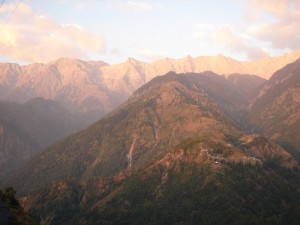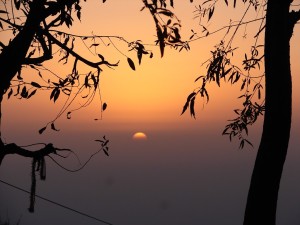Dharamsala is a special place. Given to the Dalai Lama and the Tibetan gov’t in exile in the late 50s, it is the largest Tibetan community outside of Tibet, and hometown of my friend Doka. In the last 10 years, it has become quite a tourist destination, as the popularity of the Tibetan cause, Buddhism, and new age philosophy has grown. Thus, the main street is stuffed with colorful shawls, crunchy clothing, spiritually-inclined books, and replicates of Buddhist artifacts. Had I not visited this place with Doka, I would likely have grown sick of it within 24 hours, after I’d experienced the fantastic views and breathed in the pollution-free air.
In the last 10 years, it has become quite a tourist destination, as the popularity of the Tibetan cause, Buddhism, and new age philosophy has grown. Thus, the main street is stuffed with colorful shawls, crunchy clothing, spiritually-inclined books, and replicates of Buddhist artifacts. Had I not visited this place with Doka, I would likely have grown sick of it within 24 hours, after I’d experienced the fantastic views and breathed in the pollution-free air. But Doka served as a key to this place, unlocking a door for Kaoruko and I that do not get unlocked for the typical foreigner visiting Dharamsala. That key allowed me to enter the Tibetan community of Dharamsala.
But Doka served as a key to this place, unlocking a door for Kaoruko and I that do not get unlocked for the typical foreigner visiting Dharamsala. That key allowed me to enter the Tibetan community of Dharamsala.
From the moment I arrived, I was struck by the calm strength that permeated the place.  This is a people displaced from their own country, torn away from relatives, and told by a world super-power that their land does not belong from them. Yet, with quiet resilience they have rebuilt a society for themselves – and remained warm, peaceful, incredibly giving people.
This is a people displaced from their own country, torn away from relatives, and told by a world super-power that their land does not belong from them. Yet, with quiet resilience they have rebuilt a society for themselves – and remained warm, peaceful, incredibly giving people.
I spent the next 5 days eating, talking, walking, and exploring with Doka’s relatives and friends.  An amazing lunch at one relative’s home would be followed by a nature walk (complete with beautiful sunset and lots of milk tea) and then a spinach and cheese momo dinner at another Aunty’s house. Most evenings, we managed to catch live music, whether it was an open mike night at a tourist bar, a concert by Tibetan members of the Indian army, or the excellent jam session by Dharamsala’s most famous band, JJI Exile Brothers.
An amazing lunch at one relative’s home would be followed by a nature walk (complete with beautiful sunset and lots of milk tea) and then a spinach and cheese momo dinner at another Aunty’s house. Most evenings, we managed to catch live music, whether it was an open mike night at a tourist bar, a concert by Tibetan members of the Indian army, or the excellent jam session by Dharamsala’s most famous band, JJI Exile Brothers.  Some nights we would go to Wangckuk’s, Doka’s childhood friend, house. There we would play “Tibetan pool”, listen to music, and play with Wangchuk’s cute but naughty little brother, Tashi Aloo (who can fart like you wouldn’t believe and sing “Smack That” by Akon, though he can’t speak English!).
Some nights we would go to Wangckuk’s, Doka’s childhood friend, house. There we would play “Tibetan pool”, listen to music, and play with Wangchuk’s cute but naughty little brother, Tashi Aloo (who can fart like you wouldn’t believe and sing “Smack That” by Akon, though he can’t speak English!).
The highlight of the week was the Upper TCV (Tibetan Children’s Village )School’s annual 3 day picnic. Despite the fact that his Holiness was not present this year (he was in North America -oh the irony!), it was a great time filled with cultural events. Tibetan snacks sold on the street, children making formations with their bodies, traditional Tibetan opera, and track and field events made for an entertaining few days.  The best part, though, was the lunchtime picnic. Wangchuk’s family had invited us to dine with them, so at lunch we gathered around a huge (and amazingly tasty) picnic along with Wangchuk and his entire extended family. Their kind smiles, friendly laughter, and open generosity made me feel like part of the family – and the fact that every other Tibetan family in Dharamsala was doing the exact same thing made me feel a part of the Tibetan community.
The best part, though, was the lunchtime picnic. Wangchuk’s family had invited us to dine with them, so at lunch we gathered around a huge (and amazingly tasty) picnic along with Wangchuk and his entire extended family. Their kind smiles, friendly laughter, and open generosity made me feel like part of the family – and the fact that every other Tibetan family in Dharamsala was doing the exact same thing made me feel a part of the Tibetan community.
The entire trip, however, wasn’t gift-wrapped in pretty bows, rainbows, and sunshine (whatever that means). There was a serious, dark undertone to most of the connections I made. Perhaps you know, and perhaps you don’t, about the conflict between Tibet and China. That conflict is very real for Tibetan people, and they feel it and experience the repercussions of it every day.  They are exiles, unable to communicate with relatives back home, and forced to call India home though they share nothing with the Indian people (and the Indians living in Dharamsala resent them to the core for being different). The truth is, Tibetans ARE happy, kind, giving people – but many of them are also angry. So angry that they storm the Chinese Embassy in Delhi (like one guy I met), and pour their sweat into organizations like Students for a Free Tibet (like another guy I met).
They are exiles, unable to communicate with relatives back home, and forced to call India home though they share nothing with the Indian people (and the Indians living in Dharamsala resent them to the core for being different). The truth is, Tibetans ARE happy, kind, giving people – but many of them are also angry. So angry that they storm the Chinese Embassy in Delhi (like one guy I met), and pour their sweat into organizations like Students for a Free Tibet (like another guy I met).  Many of them had to flee from Tibet at an incredibly young age, leaving their parents and relatives behind, and coming to India or Nepal to start new lives for themselves (like two other people I met).
Many of them had to flee from Tibet at an incredibly young age, leaving their parents and relatives behind, and coming to India or Nepal to start new lives for themselves (like two other people I met).
I learned a lot about the Tibetan heart – their dreams, their challenges, their troubles. Though I knew the facts about the Tibetan-China conflict before, I realized that there this conflict involves MORE than facts – it involved people; broken relationships, broken hearts, broken spirits. If you don’t know about the conflict, learn about it – and wait for an upcoming blog entry from me (I have lots to say about it now).
Wandering Footsteps: Wandering the World One Step at a Time » A travel journal following a family on their overland trip around the world.
|
|
|


